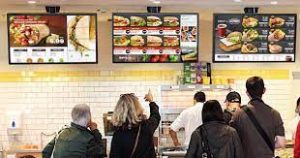One innovative tool that has been transforming the dining experience is the integration of digital menu boards for indoor signage. Traditional static menus are giving way to dynamic, interactive displays that not only enhance the aesthetic appeal of restaurants but also provide numerous benefits for both customers and business owners.

Engaging Visual Appeal:
Digital menu boards offer a vibrant and dynamic display that captures the attention of diners. With high-resolution images and eye-catching animations, these boards create a visually appealing presentation of the menu offerings. This engagement goes beyond merely listing items – it’s about creating an immersive and memorable visual experience that sets the tone for the overall dining ambiance.
Flexibility and Dynamic Content:
Unlike static menus, digital menu boards allow for easy updates and changes in real-time. Whether it’s updating prices, introducing new dishes, or promoting daily specials, restaurant owners can make instant modifications to the menu without the need for printed materials. This flexibility ensures that customers are always presented with the most current and accurate information.
Enhanced Customer Experience:
The interactive nature of digital menu boards enables a more personalized and interactive dining experience. Features such as detailed item descriptions, nutritional information, and suggested pairings can be incorporated to help customers make informed choices. The ability to display high-quality images of each dish further enhances the anticipation and satisfaction of diners.
Promotions and Upselling Opportunities:
Digital menu boards serve as powerful marketing tools. Restaurants can strategically promote specials, discounts, and limited-time offers to attract attention and drive sales. Additionally, the dynamic nature of the boards allows for upselling by featuring complementary items or suggesting add-ons, contributing to increased revenue for the establishment.
Adaptability to Changes:
In a world where menu adjustments may be necessary due to factors like seasonality or supply chain variations, digital menu boards prove invaluable. Restaurant owners can easily adapt their offerings to reflect changes in ingredients, availability, or customer preferences, ensuring a seamless and responsive approach to evolving market demands.
Operational Efficiency:
From a business perspective, digital menu boards contribute to operational efficiency. The ability to manage menus centrally, schedule content changes, and monitor performance remotely streamlines the administrative aspects of restaurant management. This not only saves time for staff but also reduces the costs associated with printing and distributing traditional menus.
Brand Consistency:
Maintaining a consistent brand image is crucial for any restaurant. Digital menu boards provide a standardized platform for presenting the menu, ensuring that the branding, color schemes, and overall aesthetic align with the restaurant’s identity. This consistency contributes to a cohesive and memorable brand experience for customers.
As the restaurant industry embraces digital transformation, digital menu boards stand out as a game-changer in enhancing the dining experience. Beyond their visual appeal, these boards offer flexibility, interactivity, and efficiency, providing a win-win for both customers and business owners. In an era where technology plays a pivotal role in shaping consumer expectations, incorporating digital menu boards is a strategic move for restaurants looking to elevate their offerings and stay ahead in a competitive market.